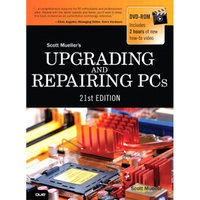Upgrading And Repairing PCs 21st Edition: Flash Storage
Comparing Flash Memory Devices
As with any storage issue, you must compare each product’s features to your needs. You should check the following issues before purchasing flash memory-based devices:
- Which flash memory products does your camera or other device support? Although adapters allow some interchange of the various types of flash memory devices, for best results, you should stick with the flash memory type your device was designed to use.
- Which capacities does your device support? Flash memory devices are available in ever-increasing capacities, but not every device can handle the higher-capacity devices. Check the device and flash memory card’s websites for compatibility information. In some cases, firmware updates can improve a device’s compatibility with larger or faster flash memory card standards.
- Are some flash memory devices better than others? Some manufacturers have added improvements to the basic requirements for the flash memory device, such as faster write speeds and embedded security. Note that these features usually are designed for use with particular digital cameras only. Don’t spend the additional money on enhanced features if your camera or other device can’t use those features.
Only ATA Flash cards can be attached directly to an older laptop computer’s PC Card slot. All other devices need their own socket or some type of adapter to transfer data. Figure 10.2 shows how the most common types of flash memory cards compare in size to each other and to a penny.

The table below provides an overview of the major types of flash memory devices and their currently available maximum capacities.
| Device | Minimum Capacity | Maximum Capacity | Notes |
|---|---|---|---|
| Compact Flash (CF+) | 16 MB | 128 GB | Highest capacity; most flexible format; supported by most DSLRs. Lexar Media and SanDisk also make faster versions of CF+ media; Lexar Media also makes LockTight secured access media. |
| SmartMedia | 16 MB | 512 MB | Popular choice for older Fujifilm and Olympus digital cameras. |
| MultiMediaCard (MMC) | 16 MB | 4 GB | MMC cards can work in most SD slots. |
| RS-MMC | 128 MB | 2 GB | Use adapter to plug in to MMC slots. |
| Secure Digital (SD) | 16 MB | 2 TB | SD cards do not work in MMC slots. Used by most brands of consumer-level digital cameras. SD High Capacity (SDHC) cards have capacities of 4 GB up to 32 GB. Devices that are compatible with SDHC can also use SD cards, but not vice versa. SDXC cards have capacities from 32 GB up to a theoretical maximum of 2 TB. Devices that are compatible with SDXC cards can also use SDHC and SD cards, but not vice versa. |
| MiniSD | 128 MB | 4 GB | Use adapter to plug in to SD slots. |
| MicroSD | 128 MB | 16 GB | Use adapter to plug in to SD slots. |
| Memory Stick | 16 MB | 128 MB | Developed by Sony and licensed to other vendors. Proprietary - not recommended. |
| Memory Stick Pro | 256 MB | 4 GB | The enhanced high-speed version of Memory Stick. Memory Stick with digital rights management support. Proprietary - not recommended. |
| Memory Stick Pro Duo | 256 MB | 16 GB | Reduced-size version of Memory Stick Pro. Proprietary - not recommended. |
| ATA Flash | 16 MB | 2 GB | Plugs directly into a PC Card (PCMCIA) slot without an adapter. |
| xD-Picture Card | 16 MB | 2 GB | Use the same brand as your digital camera for the best results. Proprietary - not recommended. |
| USB flash drive | 16 MB | 256 GB | Some include password-protection and write-protect features. |
I normally recommend only devices (cameras, PDAs, and so on) that use Secure Digital (SD, including SD variants like MiniSD or MicroSD), CompactFlash (CF), or USB flash memory. Any of the others I generally do not recommend due to proprietary designs and higher costs as well as limitations in capacity and performance.
Secure Digital has become the most popular format in modern devices. It is reasonably fast and is available in capacities approaching those of CF, and in smaller MiniSD and MicroSD formats, which are physically compatible with the full-sized SD using adapters. SD sockets also take MMC cards, which are basically thinner versions of SD. Note that the opposite is not true—MMC sockets do not accept SD cards.
CF is the most widely used format in professional devices. It offers the highest capacity, in a wide range of speeds in a reasonably small size.
Current page: Comparing Flash Memory Devices
Prev Page USB Flash Drives Next Page SD Cards And Flash Memory, ContinuedStay on the Cutting Edge
Join the experts who read Tom's Hardware for the inside track on enthusiast PC tech news — and have for over 25 years. We'll send breaking news and in-depth reviews of CPUs, GPUs, AI, maker hardware and more straight to your inbox.

